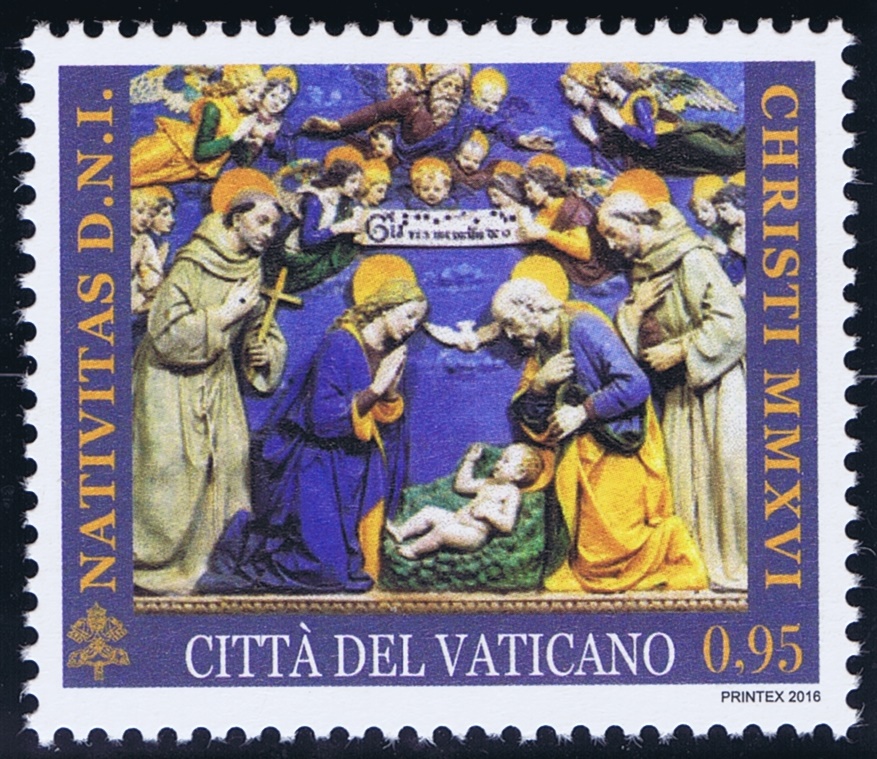
Home
 Saint Anthony of Padua Scott 993 (1995) The Feast of Saint Anthony is celebrated on June 13, the anniversary of his death in 1231. Saint Anthony was born Fernando Martins de Bulhões in Lisbon, Portugal, on August 15, 1195, into a noble family. He joined the Franciscan friars in 1220 and initially served in Ceuta (Morocco). The story goes that, while in Morocco, Anthony became seriously ill and set sail to return to Portugal. While on that voyage, the ship went off course and eventually landed in Sicily. He then made his way to Tuscany, and was eventually assigned to hermitage of Montepaolo di Dovadola ('Mount of Saint Paul of Dovadola'), near Forlì, in Romagna. It is said that St. Francis of Assisi (1181/2-1226) then chose Anthony to teach friars at Bologna and Padua. His travels were memorialized on a Vatican City souvenir sheet issued in 2021 ("Eighth Centenary of the Walk of Saint Anthony from Milazzo to Padua"), shown at the bottom of this article. Saint Anthony also preached in France, where he was known as the hammer of heretics. Over three years he wrote Sermons for Sundays, and he also participated in a commission in Rome to discuss the Rule and Testament of Saint Francis. At Padua he was known for teaching, preaching and hearing confessions, also assisting poor debtors. A large Renaissance basilica was constructed in his honor in Padua. Anthony was canonized within one year after his death in 1231 at the young age of 35. In 1263 his relics were translated within his church. An incorrupt tongue and two bones are enshrined in a separate relic chapel in the Basilica of St. Anthony. His tomb is visited by many pilgrims annually. He is often depicted carrying a lily and the child Jesus, seated on a book.  Basilica of Saint Anthony, Padua Photo by Tournasol7 From Wikimedia Commons, used under the terms of the Creative Commons Attribution-Share Alike 4.0 International license Donald Attwater writes: "He had a remarkable knowledge of the Bible, and his sermons impressed the learned no less than the simple, whether he was speaking on the behalf of right living or doctrinal truth".Since the 17th century, St. Anthony’s name has been invoked while seeking lost articles. And since the 19th century, the tradition of Saint Anthony’s Bread has been based upon his devotion to the poor and the relief of those starving. In Sicily, large loaves of bread are baked on his feast day in the shape of a crown. Saint Anthony was named a Doctor of the Church by Pope Pius XII in 1946. Recalling his writings and teachings, historian David Farmer writes: "Antony was above all an outstanding representative of the Franciscan pre-scholastic period, very close in spirit and outlook to Francis himself."Saint Anthony has been depicted on the stamps of Vatican City on three occasions. In 1995, on the stamp at the top of the article, he was honored along with Saint John of God and Saint Philip Neri as one of three "Notable Saints". He is depicted on one of the Christmas stamps from 2016, where both he and Saint Francis of Assisi are included in a view of the Nativity scene. And, in 2021, a souvenir sheet was issued to commemorate the walk of Saint Anthony to Padua following his arrival in Italy.  Christmas 2016 Scott 1639  Eighth Centenary of the Walk of Saint Anthony from Milazzo to Padua Scott 1772 (2021) REFERENCES: |